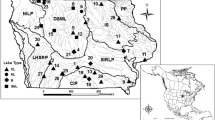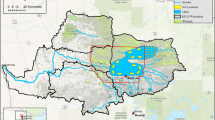Abstract
Mercury concentrations in Lake Champlain fish increased (2011–2017) for the first time in more than two decades. The increase, however, was not consistent among species or throughout the lake. Mercury concentrations in smallmouth bass and yellow perch from the three Main Lake segments increased significantly while concentrations in the eastern portions of the lake (Northeast Arm and Malletts Bay) remained unchanged or decreased; mercury concentrations in white perch remained unchanged. Factors examined to explain the increase included: atmospheric deposition, lake temperature, chlorophyll-a, fishery dynamics, lake flooding and loading of total suspended solids (TSS). This paper examines how each factor has changed between study periods and the spatial variability associated with the change. We hypothesize fishery dynamics, flooding and TSS loading may be partially responsible for the increase in fish mercury. Both growth efficiency and biomass of fish suggest mercury concentrations would increase in the Main Lake segments and decrease in the eastern portion of the lake. Additionally, two extreme climate events in 2011 resulted in extensive flooding and a four-fold increase in annual TSS loading, both potentially increasing biotic mercury with the impact varying spatially throughout the lake. Changes to the fishery and disturbance caused by extreme climatic events have increased biotic mercury and the processes responsible need further study to identify possible future scenarios in order to better protect human and wildlife health.






Similar content being viewed by others
References
Bhavsar SP, Gewurtz SB, McGoldrick, Keir MJ, Backus SM (2010) Changes in mercury levels in Great Lakes fish between 1970s and 2007. Environ Sci Technol 44:3273–3279
Chen CY, Folt CL (2005) High plankton densities reduce mercury biomagnification. Environ Sci Technol 39:115–121
Chen C, Kamman N, Williams J, Bugge D, Taylor V, Jackson B, Miller E (2012) Spatial and temporal variation in mercury bioaccumulation by zooplankton in Lake Champlain (North America). Environ Pollut 161:343–349
Dijkstra JA, Buckman KL, Ward D, Evans DW, Dionne M, Chen CY (2013) Experimental and natural warming elevates mercury concentrations in estuarine fish. PLoS ONE 8(3):e58401
Driscoll CT, Han YJ, Chen CY, Evers DC, Lambert KF, Holsen TM, Kamman NC, Munson RK (2007) Mercury contamination in forest and freshwater ecosystems in the northeastern United States. BioScience 57:17–28
Driscoll CT, Mason RP, Chan HM, Jacob DJ, Pirrone N (2013) Mercury as a global pollutant: Sources, pathways, and effects. Environ Sci Technol 47:4967–4983
Evers DC, Han Y, Driscoll CT, Kamman NC, Goodale MW, Lambert KF, Holsen TM, Chen CY, Clair TA, Butler T (2007) Biological mercury hotspots in the Northeastern United States and Southeastern Canada. Bioscience 57:29–43
Fagerstrӧm T, Jernelӧv A (1972) Some aspects of the quantitative ecology of mercury. Water Res 6:1193–1202
Gabriel MC, Williamson DG (2004) Principal biogeochemical factors affecting the speciation and transport of mercury through the terrestrial environment. Environ Geochem Hlth 26:421–434
Gandhi N, Tang RWK, Bhavsar SP, Arhonditsis (2014) Fish mercury levels appear to be increasing lately: A report from 40 years of monitoring in the Province of Ontario, Canada. Environ Sci Technol 48:5404–5414
Grigal DF (2002) Inputs and outputs of mercury from terrestrial watesheds: a review. Environ Rev 10:1–39
Hall BD, St. Louis VL, Rolfhus KR, Bodaly RA, Beaty KG, Paterson MJ, Peech Cherewyk KA (2005) Impacts of reservoir creation on the biogeochemical cycling of methyl mercury and total mercury in boreal upland forests. Ecosystems 8:248–266
Harris RC, Rudd JWM, Amyot M, Babiarz CL, Beaty KG, Blanchfield PJ, Bodaly RA, Branfireun BA, Gilmour CC, Graydon JA, Heyes A, Hintelmann H, Hurley JP, Kelly CA, Krabbenhoft DP, Lindberg SE, Mason RP, Paterson MJ, Podemski CL, Robinson A, Sandilands KA, Southworth GR, St. Louis VL, Tate MT (2007) Whole-ecosystem study shows rapid fish-mercury response to changes in mercury deposition. PNAS 104:16586–16591
Johnson I (2012) A synoptic assessment of mercury and re-evaluation of PCB’s in Lake Champlain Fishes. Lake Champlain Basin Program Technical Report No. 66 p. 63
Kamman NC, Burgess NM, Driscoll CT, Simonin HA, Goodlae W, Linehan J, Estabrook R, Hutcheson, Major A, Scheuhammer AM, Scruton D (2005) Mercury in freshwater fish of Northeast North America – A geographic perspective based on fish tissue monitoring databases. Ecotoxicology 14:163–180
Kamman N, Driscoll CT, Estabrook B, Evers DC, Miller EK (2004). Biogeochemistry of mercury in Vermont and New Hampshire lakes: An assessment of mercury in water, sediment and biota of Vermont and New Hampshire lakes. Prepared for USEPA p89
Korthals ET, Winfrey MR (1987) Seasonal and spatial variation in mercury methylation and demethylation in an oligotrophic lake. Appl Environ Micro 53:2397–2404
Le Faucheur S, Campbell PGC, Fortin C, Slaveykova VI (2014) Interactions between mercury and phytoplankton: speciation, bioavailability, and internal handling. Environ Toxicol Chem 33:1211–1224
Lester DC, McIntosh A (1994) Accumulation of polychlorinated biphenyl congeners from Lake Champlain sediments by Mysis relicta. Environ Toxicol Chem 13:1825–1841
Lin CJ, Shetty SK, Pan L, Pongprueska P, Jang C, Chu H (2012) Source attribution for mercury deposition in the contiguous United States: Regional difference and seasonal variation. J Air Waste Manag 62:52–63
Marvin-DiPasquale M, Lutz MA, Brigham ME, Krabbenhoft DP, Aiken GR, Orem WH, Hall BD (2009) Mercury cycling in stream ecosystems. 2.Benthic methylmercury production and bed sediment-pore water partitioning. Environ Sci Technol 43:2726–2732
Miller EK, Chen C, Kamman N, Shanley J, Chalmers A, Jackson B, Taylor V, Smeltzer E, Stangel P, Shambaugh A (2012) Mercury in the pelagic food web of Lake Champlain. Ecotoxicology 21:705–708
Monson BA, Staples DF, Bhavsar SP, Holsen TM, Schrank CS, Moses SK, McGoldrick DJ, Backus SM, Williams KA (2011) Spatiotemporal trends in mercury in walleye and largemouth bass from the Laurentian Great Lakes Region. Ecotoxicology 20:1555–1567
Monson BA (2009) Trend reversal of mercury concetrations in piscivorous fish from Minnesota lakes: 1982-2006. Environ Sci Technol 43:1750–1755
Paranjape AR, Hall BD (2017) Recent advances in the study of mercury methylation in aquatic systems. FACETS 2:85–119
Pientka B, Staats NR (2018) Lake Champlain forage fish assessment. Vt Fish Wildl Dep Annu Rep. 2018:p133
Ramlal PS, Kelly CA, Rudd JWM, Furutani A (1993) Sites of methyl mercury production in remote Canadian Shield lakes. Can J Fish Aquat Sci 50:972–979
Rand PS, Stewart DJ (1998) Dynamics of salmonine diets and foraging in Lake Ontario, 1983-1993: a test of a bioenergetics model prediction. Can J Fish Aquat Sci 55:307–317
Shanley JB, Chalmers AT (2012) Streamwater fluxes of total mercury and methylmercury into and out of Lake Champlain. Environ Pollut 161:311–320
Shanley JB, Donlon AF, Scherbatskoy T, Keeler GJ (1999) Mercury cycling and transport in the Lake Champlain Basin. In: Manley TO, Manley PL (eds) Lake Champlain in Transition: From Research Toward Restoration. American Geophysical Union, Washington, DC, p 277–299
Simonin PW, Rudstam LG, Parrish DL, Pientka B, Sullivan PJ (2018) Piscivore diet shifts and trophic level change after Alewife establishment in Lake Champlain. T Am Fish Soc 147:939–947
Simonin PW, Parrish DL, Rudstam LG, Sullivan PJ, Pientka B (2012) Native rainbow smelt and nonnative alewife distribution related to temperature and light gradients in Lake Champlain. J Gt Lakes Res 38:115–122
Smeltzer E, Shambaugh AD, Stangel P (2012) Environmental change in Lake Champlain revealed by long-term monitoring. J Gt Lakes Res 38:6–18
Troy A, Wang D, Capen D, O’Niel-Dunne J, MacFaden S (2007) Updating the Lake Champlain Basin land use data to improve prediction of phosphorus loading. Lake Champlain Basin Program Tech Rep. No. 54:121
Trudel M, Rasmussen JB (2006) Bioenergetics and mercury dynamics in fish: A modelling perspective. Can J Fish Aquat Sci 63:1890–1902
U.S. Census Bureau (2011) Statistical Abstract of the United States: Largest Lakes in the United States
US EPA (2013) 2011 national listing of fish advisories technical report. EPA-820-F-13-058, US EPA, Washington, DC p8
UNEP (2013) Global mercury assessment: Sources, emissions, release and environmental transport. United Nations Environment Programme Chemicals Branch, Geneva, Switzerland p.44
Ward DM, Nislow KH, Flot CL (2010a) Bioaccumulation syndrome: identifying factors that make some stream food webs prone to elevated mercury bioaccumulation. Ann NY Acad Sci 1195:62–83
Ward DM, Nislow KH, Chen CY, Folt CL (2010b) Rapid, efficient growth reduces mercury concentrations in stream-dwelling Atlantic salmon. Trans Am Fish Soc 139:1–10
Yu X, Driscoll CT, Montesdeoca M, Evers D, Duron M, Williams K, Schoch N, Kamman NC (2011) Spatial patterns of mercury in biota of Adirondack, NY lakes. Ecotoxicology 20:1543–1554
Acknowledgements
We would like to thank Dr. Richard Bopp for his guidance and assistance analyzing fish samples. Neil Kamman, Bernie Pientka, James Shanley, Angela Shambaugh and Fred Dunlap for comments and advice on the project. And anonymous reviewers for comments and suggestions on the manuscript.
Funding
This project was selected for funding by the Lake Champlain Basin Program (LCBP) Steering Committee and it has been supported directly by an agreement or sub-award issued by the New England Interstate Water Pollution Control Commission (NEIWPCC). NEIWPCC manages LCBP’s personnel, contracts, grants, and budget tasks through a partnership with the LCBP Steering Committee.
Author information
Authors and Affiliations
Corresponding author
Ethics declarations
Conflict of interest
The authors declare that they have no conflict of interest.
Ethical approval
All procedures performed in studies involving animals were in accordance with the ethical standards of Rensselaer Polytechnic Institute.
Informed consent
Informed consent was obtained from all individual participants included in this study.
Additional information
Publisher’s note Springer Nature remains neutral with regard to jurisdictional claims in published maps and institutional affiliations.
Supplementary information
Rights and permissions
About this article
Cite this article
Swinton, M.W., Nierzwicki-Bauer, S.A. Mercury increase in Lake Champlain fish: links to fishery dynamics and extreme climatic events. Ecotoxicology 29, 1750–1761 (2020). https://doi.org/10.1007/s10646-019-02148-5
Accepted:
Published:
Issue Date:
DOI: https://doi.org/10.1007/s10646-019-02148-5




